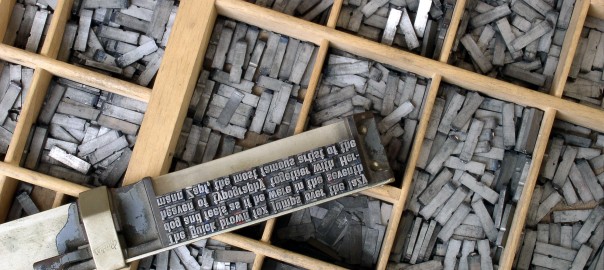Back in the Day . . .
 Before Johannes Gutenberg invented movable type back in the 1400s, the handwritten manuscript was the method of recording and communicating information of the day.
Before Johannes Gutenberg invented movable type back in the 1400s, the handwritten manuscript was the method of recording and communicating information of the day.
Gutenberg came up with a process for mass-producing movable type which included a type metal alloy and a hand mould for casting type.
He also was the first to use oil-based ink and he invented a wooden screw-type printing press.
Gutenberg’s inventions were regarded as the introduction to the era of mass communication. This altered the course of history, which markedly improved literacy in the middle class.
From manually operated presses, to steam-driven and beyond, the printing industry flew ahead in leaps and bounds.
The Salmon Arm Observer saw its first Newspaper Issue roll off the Press in 1907.
At this time, newspaper articles and job printing layouts were handset into lines, paragraphs and pages, by painstakingly handpicking individual letters of foundry type from the type cases.
In the late 1920’s or early 1930’s, type was set by means of the Linotype, the invention which revolutionized the printing industry, making it possible to increase productivity many times over.
This machine, a Rube Goldberg wonder, transferred letters of type from special brass matrices to molds (lines of type) created from molten lead.
From that time until 1973, the Observer newspaper and commercial printing department were printed by the letterpress method. The newspaper was printed on a Goss Coxotype and the commercial printing was done on Heidelberg Platen, Holmes Vertical, Chandler and Price Platen presses.
Hucul Printing Ltd.’s founders, myself, Bernie Hucul, and brother, Gary Hucul, toiled as printers devils in an era of printing where lead melting pots, inky press forms and volatile press chemicals ruled the day.
At this time, the production method was switched over to Offset Printing.
Typeset was via a phototypesetting method, where keyboard operators typed on simple computerized machines which transferred type onto photosensitive paper.
The prints, now on strips of paper, were then pasted up onto master grid sheets which duplicated the newspaper page.
Photographs were processed into halftone prints and were added to the paste-up sheets, along with the advertizing setups.
Graphic art cameras then copied the newspaper pages onto negative film to facilitate a platemaking process, where the negative image was transfered to light sensitive aluminum press plates.
And of course, newspaper and print production, then saw desktop publishing come to the forefront with the introduction of personal computers.
In 1989, Hucul Printing Ltd. was formed when the brothers, Bernie and Gary Hucul purchased the commercial printing department of the Salmon Arm Observer from Cariboo Press.
The business then carried on using a combination of letterpress and offset printing methods.
Some of the old letterpress printing presses are still in use, but they are now taking a backseat to the Heidleberg and Hamada offset presses.
More recently, the company has added digital printing equipment, using toner-based inks, along with a large format inkjet printer, which are capable of printing in glorious full colour.






